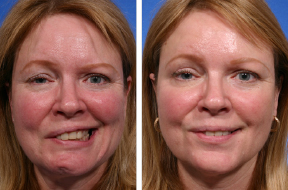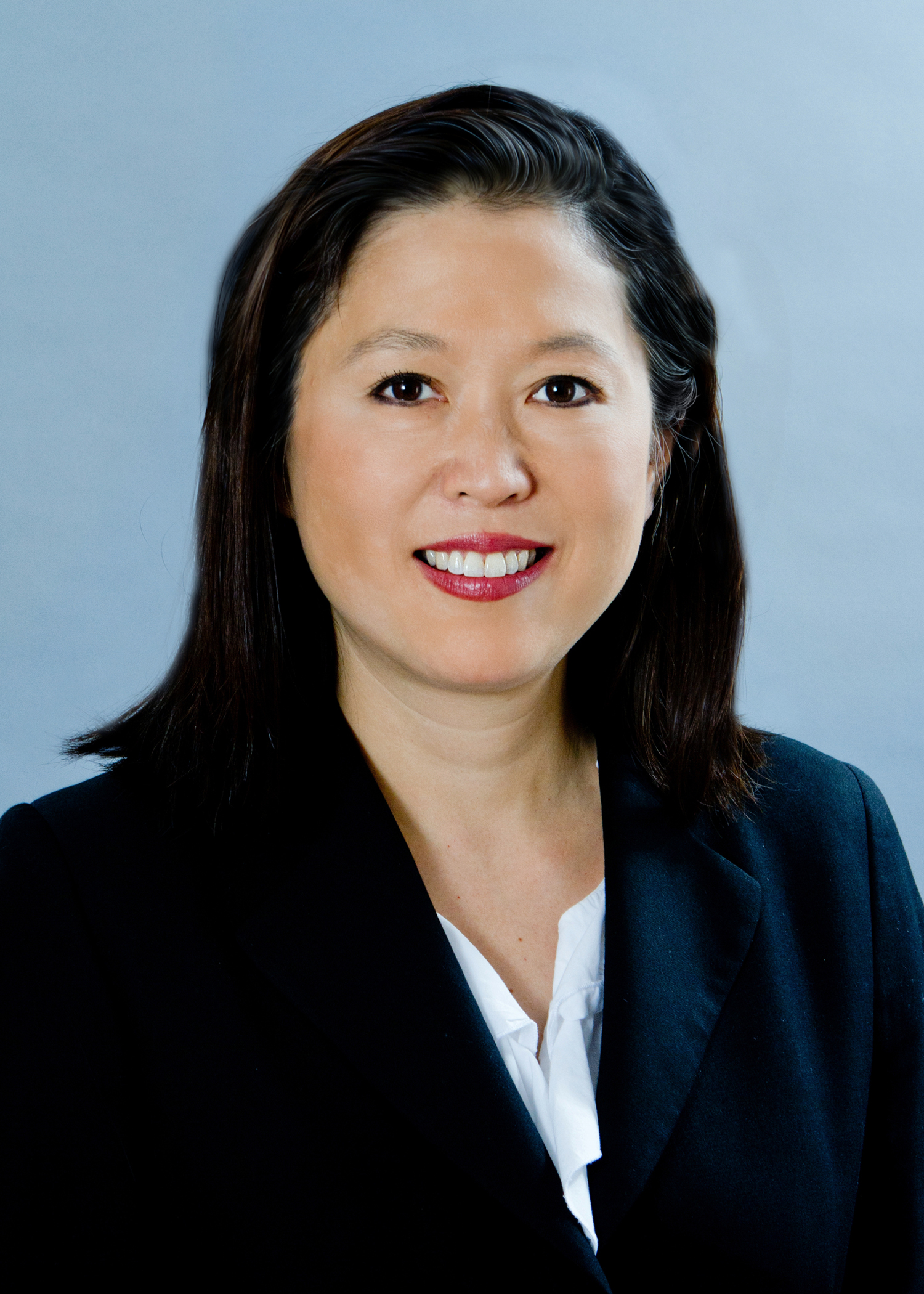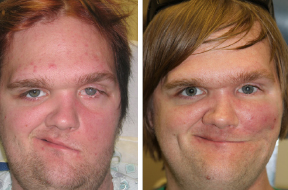The facial nerve is the nerve of facial expression. Facial nerve paralysis occurs when the facial nerve no longer works properly. Causes include Bell’s Palsy, a tumor requiring removal of a portion of the facial nerve, trauma, diseases and infections. The effects can be devastating. Not only do patients struggle with significant changes in their physical appearance and the ability to express emotion and communicate, but they can also experience vision loss, nasal blockage and difficulty with eating and drinking. Consequently, the majority of patients experience social withdrawal and depression.
The U-M Facial Nerve Disorders Clinic exists to address the many challenges faced by patients with facial nerve disorders. Comprised of members from facial plastic surgery, neurotology, audiology, occupational therapy and oculoplastic surgery, the Facial Nerve Disorders Clinic enables us to offer individualized approaches to treat all aspects of facial paralysis.

Patient Profile: Ann Mayo
Treating Bell's Palsy with Synkinesis with Botox and Occupational Therapy
A common cause of facial nerve paralysis is Bell's Palsy– temporary paralysis or weakness of the muscles on one side of the face. Most patients with Bell's Palsy make a full recovery, but in 15-20% of cases, the nerve can be permanently injured or may recover imperfectly, resulting in synkinesis– unintentional, mass movement of the facial muscles. Not only can synkinesis cause facial discomfort, but it is distressing to patients, who experience facial asymmetry both at rest and with expression.
Ann Mayo was in her eight month of pregnancy when she was diagnosed with Bell's Palsy with synkinesis. For nearly 20 years, Ann struggled with right-side drooping and muscle spasms. "It was difficult. I'm a first grade teacher. It's my job to teach young children new sounds and words, but I couldn't make those sounds and words without holding my cheek, due to the facial paralysis. Try explaining that to a group of six- and seven-year olds!"

In 2010, while surfing the Web for potential facial paralysis treatments, Ann stumbled across the U-M Facial Nerve Disorders Clinic. Impressed by the possibilities offered by U-M, she made an appointment to see Jennifer C. Kim, M.D.
Upon presenting at our Facial Nerve Disorders Clinic, Ann had synkinesis on her right side, resulting in significant asymetries of her smile, eye and brow. Dr. Kim suggested serial Botox injections, which she later reinforced with the addition of occupational therapy for neuromuscular training. "I was so excited to try this treatment! No surgery, the potential of balancing my face and retaining my muscles - I was thrilled!" says Ann.
Now almost three years later, Ann notes significant improvement. "You can hardly notice the drooping, and I am much more effective at work."
Ann continues to receive Botox injections every 3-4 months. She no longer attends occupational therapy, as she does the exercises on her own.

Patient Profile: Brandon Haag
Facial Nerve Reanimation
Another common cause of facial nerve paralysis is when a tumor requires removal of a segment of the facial nerve. However undesirable, sometimes the benefits of cutting the facial nerve in order to remove the tumor outweigh the consequences.
This was the case for Brandon Haag, a 26 year-old who presented at our Facial Nerve Disorders Clinic with left facial nerve paralysis following resection of an acoustic schwannoma. "After several surgeries, the tumor was removed, but I was left with facial nerve paralysis, so I was referred to Dr. Kim," says Brandon.
Although the left side of Brandon's face was paralyzed, he still had full function of his right side. Dr. Kim recommended facial nerve repair via cross-facial nerve graft. During this procedure, the sural nerve is harvested from the leg and used to connect to a branch of the functioning facial nerve from the right side of the face. Nine to 12 months is allowed for the nerve axons to regenerate across the face via the sural nerve graft. A second surgery is performed about a year later to transplant the gracilis muscle from the thigh. Microvascular surgery is performed to reconnect blood vessels and the sural nerve to the motor nerve of the muscle. Another 6 months are required for the nerve axons to regenerate and power the transplanted leg muscle. “Because the nerve input to the transplanted muscle is from the opposite intact facial nerve, this option is unique in that it provides a natural emotional smile in contrast to other reanimation surgeries,” Dr. Kim says.
"At first, I was unsure about the procedure. I had never heard of something like this. But I trusted Dr. Kim," Brandon says.
Brandon underwent cross-facial nerve grafting in February 2009. After giving the nerves months to regenerate, Dr. Kim saw Brandon for follow-up in September 2009. Pleased with his progress, Dr. Kim felt he would benefit from a free gracilis muscle transfer to reanimate the left face. In October 2009, Brandon underwent the second stage of surgery.
Over the course of 18 months, Brandon experienced notable improvements in reanimation of the left side of his face. Now three years later, 28-year-old Brandon continues to improve and thrive. He follows up with Dr. Kim and an occupational therapist every three months. "I've come a long way through all of this," Brandon says. "It hasn't been easy, but it's been worth it."
